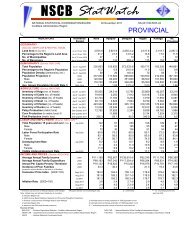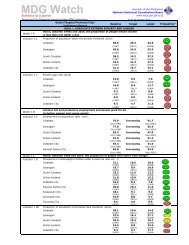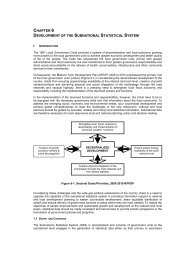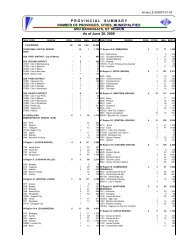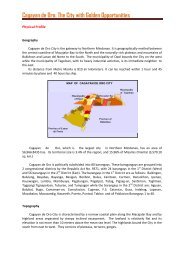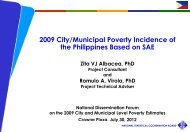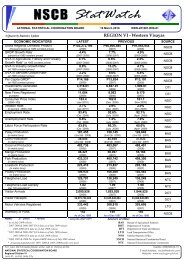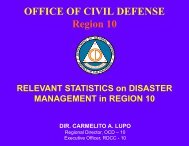Accumulation of Mercury and Other Heavy Metals in Some ... - NSCB
Accumulation of Mercury and Other Heavy Metals in Some ... - NSCB
Accumulation of Mercury and Other Heavy Metals in Some ... - NSCB
You also want an ePaper? Increase the reach of your titles
YUMPU automatically turns print PDFs into web optimized ePapers that Google loves.
D. Metal concentrations <strong>in</strong> the bottom sedimentsD.1 <strong>Mercury</strong> <strong>and</strong> goldSediments serve as s<strong>in</strong>ks for heavy metals <strong>and</strong> for metals with high aff<strong>in</strong>ityfor organic particles such as mercury will be elevated <strong>in</strong> organic rich sediments(Skei, 1978; Luoma, 1989). Generally, as gra<strong>in</strong> size decreases, the concentration<strong>of</strong> metals adsorbed onto sediments <strong>in</strong>creases, particularly across the transitionzone from silt to clay (< 4 – 63 µm) (Deely et al., 1992). Except for Station 8,which exhibited the highest Hg <strong>and</strong> Au contents (58.15 µg/g & 254.29 µg/grespectively), most <strong>of</strong> the stations with smaller particle size showed higherconcentrations for Hg <strong>and</strong> Au. Gold was also highest (254.3 µg/g) at station 8followed by station 4 (21.4 µg/g).Stations 2, 9 <strong>and</strong> 10 also serve as monitor<strong>in</strong>g stations for neighbor<strong>in</strong>gregion (DENR-X) <strong>and</strong> the results they obta<strong>in</strong>ed for their June 1999 sampl<strong>in</strong>g(Manzano <strong>and</strong> Daitia, 1999) were about two orders <strong>of</strong> magnitude higher than ourOctober samples. This difference may be a result <strong>of</strong> differences <strong>in</strong> procedures forthe extraction <strong>of</strong> total metals from the sediments used. In our study, total metalconcentrations <strong>in</strong> the sediments were measured accord<strong>in</strong>g to the procedurereported by Tessier et al. (1979) <strong>and</strong> Bervoets et al. (1998). <strong>Mercury</strong> <strong>in</strong> riversediments from Eastern M<strong>in</strong>danao (Williams et al., 1995) was <strong>in</strong> the range <strong>of</strong> 0.02mg/kg <strong>and</strong> 23 mg/kg with<strong>in</strong> the m<strong>in</strong><strong>in</strong>g site, five times higher than what this studymeasured. Compared with other studies Sasamal et al. (1987), Craig <strong>and</strong>Moreton (1983), Park <strong>and</strong> Curtis (1997) recorded similar values.D.2 <strong>Other</strong> metalsEven for the other metals, Station 8 had the highest concentration, exceptfor lead which was high <strong>in</strong> Station 4 (331 µg/g) <strong>and</strong> Station 5 (286 µg/g). Hamilton(1989) reported similar concentrations for cadmium <strong>in</strong> the Northeast Pacific.E. <strong>Heavy</strong> metal concentrations <strong>in</strong> <strong>in</strong>vertebrate species <strong>in</strong> the bayFrom the total <strong>of</strong> 10 species collected dur<strong>in</strong>g our sampl<strong>in</strong>g exercise, onlyfour species were present <strong>in</strong> more than 3 stations. The other species were eitherpresent only at one or two stations. Metal concentrations varied from one stationto other <strong>and</strong> with species.E.1 <strong>Mercury</strong> <strong>and</strong> goldAmong the sampled species <strong>in</strong> the bay, Circe scripta <strong>in</strong> Station 2 had thehighest mercury content, 9.2 µg/g, followed by Placuna ephippium also <strong>in</strong> Station2 with 4.32 µg/g, Tectus fenestratus <strong>and</strong> Strombus sp. <strong>in</strong> Station 3 with 3 µg/g<strong>and</strong> 2.74 µg/g respectively. <strong>Other</strong> species that showed high mercuryconcentration <strong>in</strong>clude Tectus fenestratus from Station 2 with 2.72 µg/g; Anadarascapha <strong>in</strong> Station 4 with 1.66 µg/g; <strong>and</strong> Littor<strong>in</strong>a scabra from Station 6 with 1.58µg/g. The rest <strong>of</strong> the species had less than 1 µg/g concentration.



